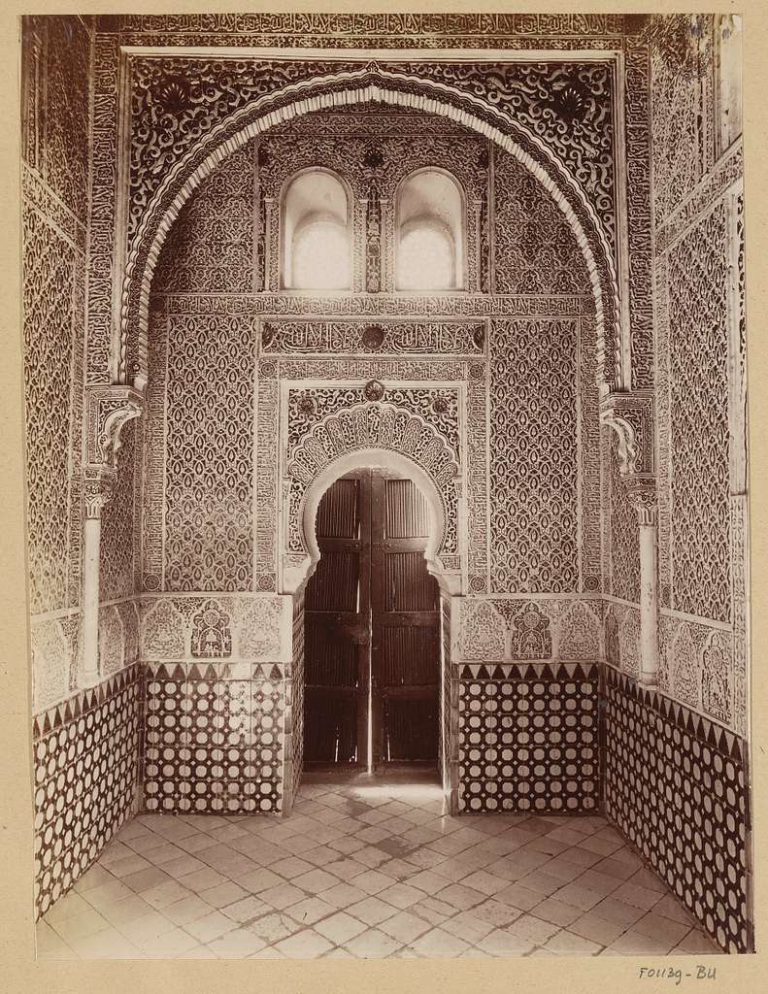Do you ever do this, when you look at wallpaper or wrapping paper with a pattern, you try to figure out how the pattern repeats itself? Often, you can discover a repetition by mentally shifting or rotating the design. The pattern repeats itself in a regular way until the paper or fabric ends… But in your imagination, the design could continue infinitely.
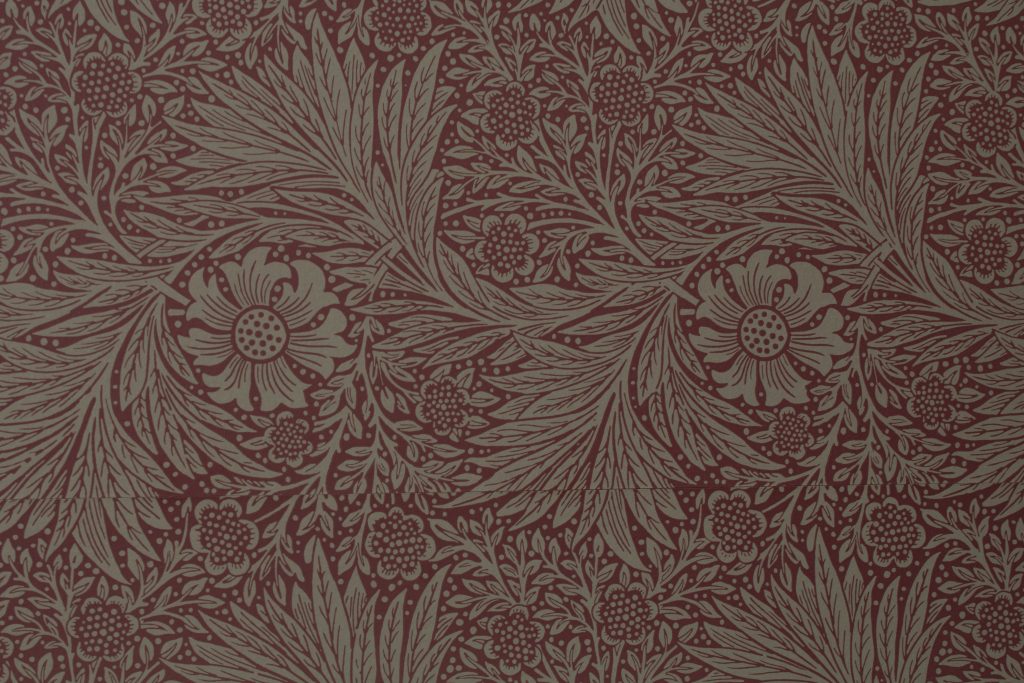
In the image above, you can clearly see that the left flower and leaves are exactly the same as the right flower and leaves. You can shift the left flower so that the patterns align perfectly on top of each other. You could also likely move the two flowers up or down, as the wallpaper pattern repeats in that direction as well. The centers of the flowers form a square, or rather, a quadrilateral. In this example, rotating or reflecting the pattern doesn’t work.
The pattern contains only translations; there are no rotations, reflections, or glide reflections (identified as Group p1, see the overview further down in this article).
In the next example, there is indeed mirror symmetry. The mirror lines run parallel to each other. This allows us not only to shift the pattern – in this case, the shortest path is diagonal – but also to mirror it. The angles at which we shift the pattern don’t matter.
This pattern has no rotations. It has reflection axes; they are all parallel. (Group pm)
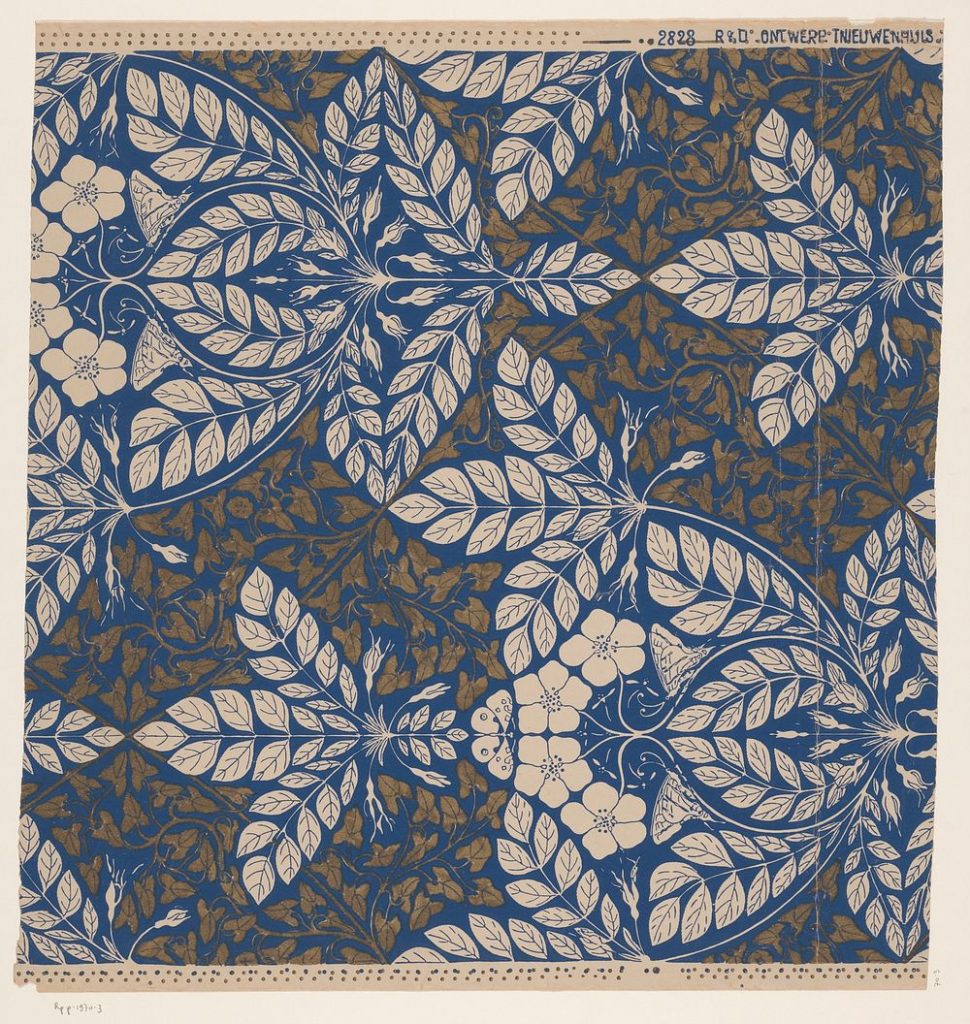
This pattern has a horizontal mirror symmetry.
A sliding reflection is a reflection with a shift – think of a trail of footprints in the sand – that is also quite common. Below is an example of a paving pattern. I find this one difficult to see, but the axes of reflection run diagonally and perpendicularly to each other. After the reflection, you need to slide over by the width of one stone (the ripples in the stones count towards the pattern).
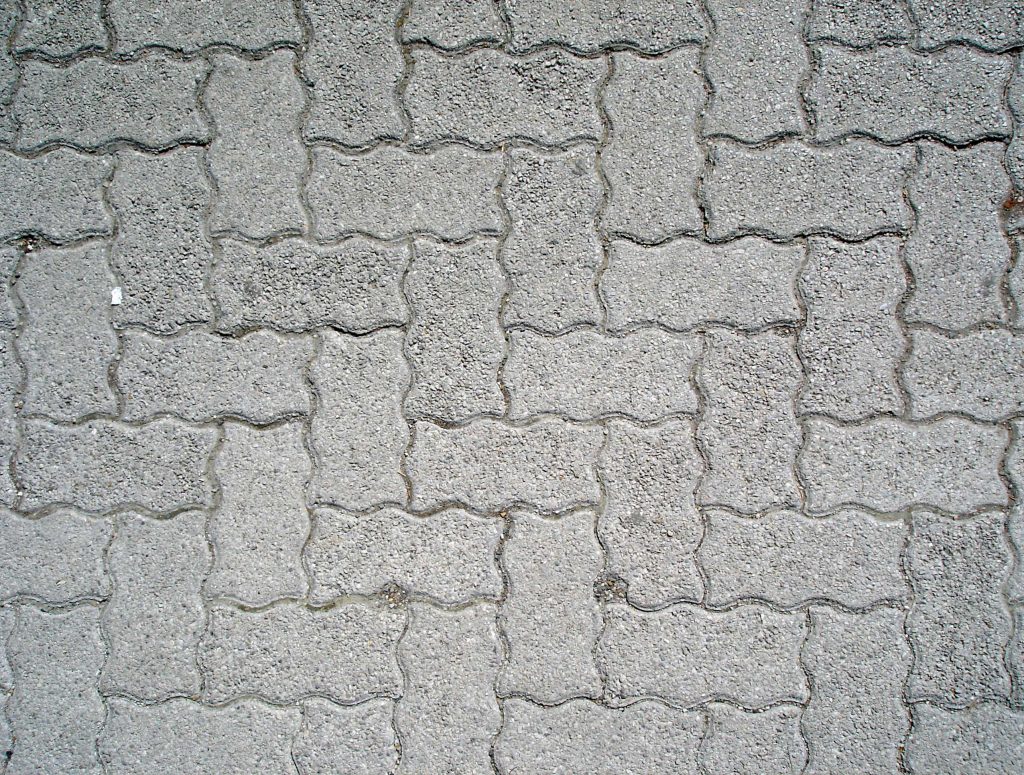
Sometimes, the figures may be rotated and repeated. In such cases, we refer to the pattern as having rotational symmetry. There are only a few specific angles of rotation to consider: namely 60°, 90°, 120°, and 180° (which correspond to 6, 4, 3, and 2 orders of rotation, respectively). Other angles cannot be used, as they would result in gaps or overlaps (360° is indeed a multiple of 60°, 90°, 120°, and 180°). Below is an example of a pattern exhibiting 180-degree rotational symmetry.
This pattern contains four rotation centers of order two (180°) but no reflections or glide reflections (Group p2).
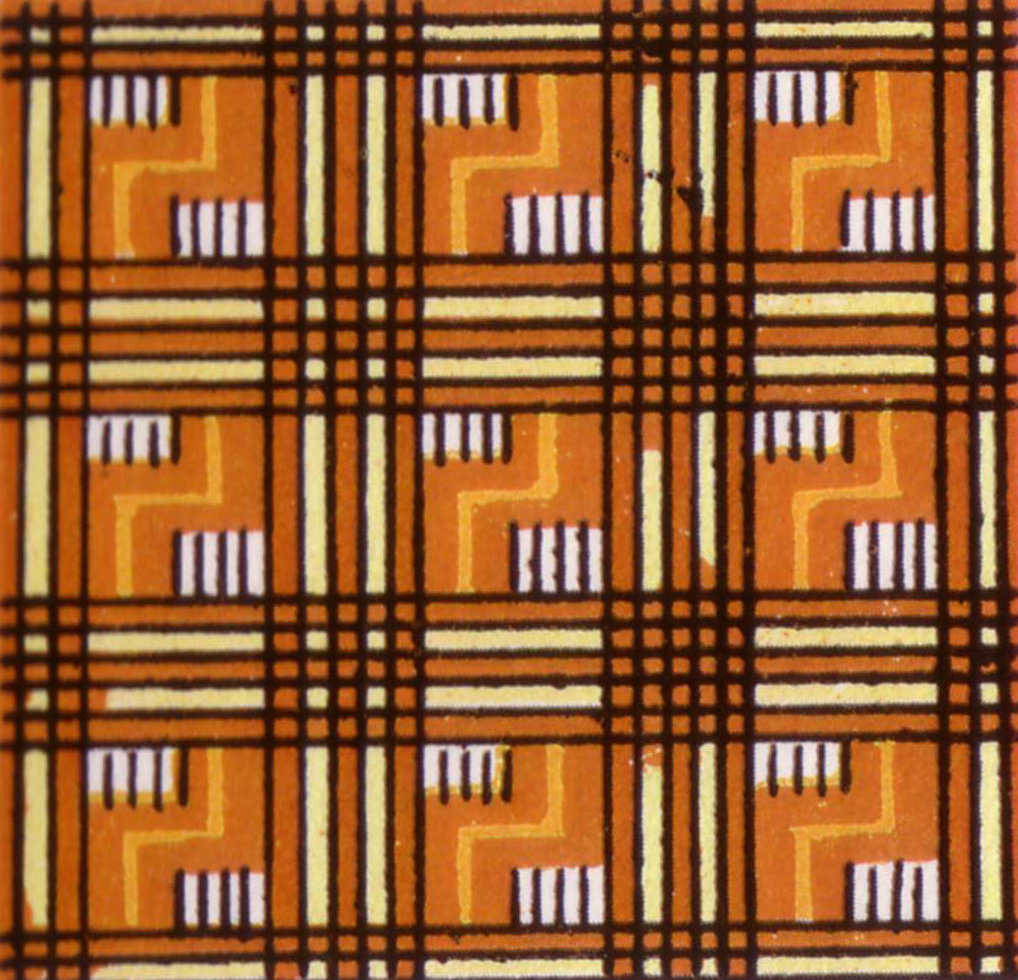
Overview of all 17 possibilities
The above can be practically combined in various ways. The mathematician Evgraf Fedorov proved in 1891 that there are exactly 17 different wallpaper groups. In 1891 George Pólya then derived them independently. A group is a sort of smallest “number system.” You might recall from school that there was a mention of the set of all integers ℤ. This is an example of a group. For a collection to call itself a group, we need a “rule” that, when applied to two elements – these can be two identical elements – produces another element from that group. We take the set ℤ and add two numbers together; this yields another number from ℤ.
So a group is a collection with an operation defined on that collection. But before that collection can be considered a group, three more conditions must hold:
- The group operation must be associative; in the case of ℤ and the group operation addition, it holds that (N+M) + A = N + (M+A) where N, M, and A are elements of ℤ.
- The collection must contain a unit element that is part of the collection. In ℤ with the group operation of addition, this element is 0.
- We also need an inverse, which is also included in the set. For ℤ, these are the negative numbers N + (-N) = 0 = (-N) + N.
So if the above 3 rules apply, then we can “calculate” with our wallpaper. I want to elaborate on this in a future article.
- The group p1 contains only translations; there are no rotations, reflections, or glide reflections.
- The group p2 contains four rotation centers of order two (180°), but no reflections or glide reflections.
- The group pm has no rotations. It has reflection axes, they are all parallel.
- The group pg contains glide reflections only, and their axes are all parallel. There are no rotations or reflections.
- The group cm contains no rotations. It has reflection axes, all parallel. There is at least one glide reflection whose axis is not a reflection axis; it is halfway between two adjacent parallel reflection axes.
- The group pmm has reflections in two perpendicular directions, and four rotation centers of order two (180°) located at the intersections of the reflection axes.
- The group pmg has two rotation centers of order two (180°), and reflections in only one direction. It has glide reflections whose axes are perpendicular to the reflection axes. The centers of rotation all lie on glide reflection axes.
- The group pgg contains two rotation centers of order two (180°), and glide reflections in two perpendicular directions. The centers of rotation are not located on the glide reflection axes. There are no reflections.
- The group cmm has reflections in two perpendicular directions, and a rotation of order two (180°) whose center is not on a reflection axis. It also has two rotations whose centers are on a reflection axis.
- The group p4 has two rotation centers of order four (90°), and one rotation center of order two (180°). It has no reflections or glide reflections.
- The group p4m has two rotation centers of order four (90°), and reflections in four distinct directions (horizontal, vertical, and diagonals). It has additional glide reflections whose axes are not reflection axes; rotations of order two (180°) are centered at the intersection of the glide reflection axes. All rotation centres lie on reflection axes.
- The group p4g has two centers of rotation of order four (90°), which are each other’s mirror image, but it has reflections in only two directions, which are perpendicular. There are rotations of order two (180°) whose centers are located at the intersections of reflection axes. It has glide reflections axes parallel to the reflection axes, in between them, and also at an angle of 45° with these.
- The group p3 has three different rotation centers of order three (120°), but no reflections or glide reflections.
- The group p3m1 has three different rotation centers of order three (120°). It has reflections in the three sides of an equilateral triangle. The center of every rotation lies on a reflection axis. There are additional glide reflections in three distinct directions, whose axes are located halfway between adjacent parallel reflection axes.
- The group p31m has three different rotation centers of order three (120°), of which two are each other’s mirror image. It has reflections in three distinct directions. It has at least one rotation whose centre does not lie on a reflection axis. There are additional glide reflections in three distinct directions, whose axes are located halfway between adjacent parallel reflection axes.
- The group p6 has one rotation centre of order six (60°); two rotation centers of order three (120°), which are each other’s images under a rotation of 60°; and three rotation centers of order two (180°) which are also each other’s images under a rotation of 60°. It has no reflections or glide reflections.
- The group p6m has one rotation centre of order six (60°); it has two rotation centers of order three, which only differ by a rotation of 60° (or, equivalently, 180°), and three of order two, which only differ by a rotation of 60°. It has also reflections in six distinct directions. There are additional glide reflections in six distinct directions, whose axes are located halfway between adjacent parallel reflection axes.
I am not going to prove that the above 17 wallpaper groups are mathematical groups, but what I want to convey is that when you slide the wallpaper and then slide it back, the latter can be seen as the inverse of the first shift, just as with rotation, reflection, and glide reflection. In this case, doing nothing serves as your identity element. And if you perform all these operations in any order and one after another, you can also calculate that the operations are associative. Go ahead and experiment with this yourself. So, no proof, but you will get a sense of what wallpaper groups are and how you can “calculate” with them.
In art
In art-related blogs (lake: “Behangpapier en kunst” ) connected to this post, I want to discuss certain artists like M.C. Escher. I also intend to explore artistic expressions from other cultures, such as Arabic tile patterns, like those found in the Blue Mosque.
references:
- https://behangpatroon.wordpress.com/inleiding/
- https://en.wikipedia.org/wiki/Wallpaper_group
- https://nl.wikipedia.org/wiki/Behangpatroongroep
- https://archief.vakbladeuclides.nl/bestanden/090_2014-15_07_kloosterboer.pdf
- WISKUNDE Wetenschap van patronen en structuren Keith Devlin

